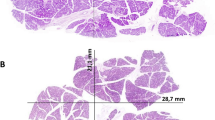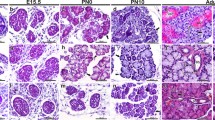Summary
The phenotypic expression of the human epidermal growth factor (EGF) was investigated immunohistochemically in human foetal submandibular glands from the 5th to 10th month of gestation, adult normal submandibular glands and 48 cases of pleomorphic adenomas. In foetal submandibular glands, both the terminal buds and primary ducts at the intermediate stage of gestation were positive for EGF, and in particular, the outer layer cells of primary ducts showed strong EGF-immunoreactivity. EGF-positive cells decreased as the gestational stage advanced and only ductal cells were weakly positive for EGF at the terminal stage of gestation. In the adult normal submandibular gland, weak immunoreactivity for EGF was restricted to ductal cells. However, 41 (86%) of the 48 pleomorphic adenomas had EGF-positive cells which were distributed among the ductal, chondroid and myxoid portion. No EGF-immunoreactivity was detected in the solid portion of pleomorphic adenomas. These results suggest that EGF may play an important role in the growth and differentiation of foetal cells as well as the proliferation of tumour cells in pleomorphic adenomas.
Similar content being viewed by others
References
Carpenter G, Cohen S (1979) Epidermal growth factor. Ann Rev Biochem 48:193–216
Cohen S (1962) Isolation of a submaxillary gland protein accelerating incisor eruption and eyelid opening in the newborn animal. J Biol Chem 237:1555–1562
Cohen S, Carpenter G (1975) Human epidermal growth factor: Isolation and chemical and biological properties. Proc Natl Acad Sci USA 72:1317–1321
Cohen S, Savage CR Jr (1974) Recent studies on the chemistry and biology of epidermal growth factor. Recent Prog Horm Res 30:551–574
Cohen S, Tailar JM (1974) Epidermal growth factor: Chemical and biological characterization. Recent Prog Horm Res 30:533–550
Cohen S, Ushiro H, Stocheck C (1982) A native 170,000 epidermal growth factor receptor-kinase complex from shed membrane vesicles. J Biol Chem 257:1523–1531
Curran T, Miller AD, Zokas L (1984) Viral and cellularfos proteins: A comparative analysis. Cell 36:259–268
ba]Dailey GE, Kraus JW, Orth DN (1978) Homologous radioimmunoassay for human epidermal growth factor (urogastrone). J Clin Endocrinol Metabol 46:929–936
Downward J, Yarden Y, Mates E (1984) Close similarity of epidermal growth factor receptor and v-erb-B oncogene protein sequences. Nature 307:521–527
Elder JB, Williams G, Lacey E (1978) Cellular localization of human urogastrone/epidermal growth factor. Nature 271:466–467
Gregory H (1975) Isolation and structure of urogastrone and its relationship to epidermal growth factor. Nature (Lond) 257:325–328
Gresik EW, Barka T (1977) Immunocytochemical localization of epidermal growth factor in mouse submandibular gland. J Histochem Cytochem 25:1027–1035
Hayashi Y (1987) Expression of Ha-ras p21 in human salivary gland carcinomas. Tr Soc Pathol Jpn (suppl) 76:214
Heitz P, Kasper M, Noorden VS, Polak JM, Gregory H, Pearse AGE (1978) Immunohistochemical localization of urogastrone to human duodenal and submandibular glands. Gut 19:408–413
Hirata Y, Orth DN (1979a) Epidermal growth factor (urogastrone) in human tissues. J Clin Endocrinol Metabol 48:667–672
Hirata Y, Orth DN (1979b) Epidermal growth factor (urogastrone) in human fluid. J Clin Endocrinol Metabol 48:673–679
Hsu SM, Raine L, Fanger H (1981) Use of avidin-biotin-peroxidase complex (ABC) in immunoperoxidase techniques: A comparison between ABC and unlabeled antibody (PAP) procedures. J Histochem Cytochem 29:577–580
Kamata T, Feramisco JR (1984) Epidermal growth factor stimulates guanine binding activity and phosphorylation ofras oncogene proteins. Nature 310:147–150
Kasselberg AG, Orth DN, Gray ME, Stahlman MT (1985) Immunocytochemical localization of human epidermal growth factor/urogastrone in several human tissues. J Histochem Cytochem 33:315–322
Mulcahy LS, Smith MR, Stacey DW (1985) Requirement forras proto oncogene function during serum-stimulated growth of NIH 3T3 cells. Nature 313:241–243
Muller R, Bravo R, Burckhardt J (1984) Induction of c-fos gene and protein by growth factors precedes activation of c-myc. Nature 312:716–720
Noorden von S, Heitz P, Kasper M, Pearse AGE (1977) Mouse epidermal growth factor: Light and electron microscopical localization by immunocytochemical staining. Histochemistry 52:329–340
Persson H, Leden P (1984) Nuclear localization and DNA binding properties of a protein expressed by human c-myc oncogene. Science 225:718–721
Poulsen SS, Nexo E, Olsen PS, Hess J, Kirkegaard P (1986) Immunocytochemical localization of epidermal growth factor in rat and man. Histochemistry 85:389–394
Starkey RH, Cohen S, Orth DN (1975) Epidermal growth factor: Identification of a new hormone in human urine. Science 189:800–803
Starkey RH, Orth DN (1977) Radioimmunoassay of human epidermal growth factor (urogastrone). J Clin Endocrinol Metabol 45:1144–1153
Sumiyoshi H, Taniyama K, Yasui W, Tahara E, Sakamoto S, Hayashi H, Nagatsuka S (1986) Localization of human epidermal growth factor in various human tissues. Tr Soc Pathol Jpn 75:135–136
Tahara E, Sumiyoshi H, Hata J, Yasui W, Taniyama K (1986a) Human epidermal growth factor in gastric carcinomas as a biologic marker of high malignancy. Jpn J Cancer Res (Gann) 77:145–152
Tahara E, Yasui W, Taniyama K (1986b) Ha-ras oncogene product in human gastric carcinoma: Correlation with invasiveness, metastasis or prognosis. Jpn J Cancer Res (Gann) 77:517–522
Thackray AC, Lucas RB (1974) Tumors of the major salivary glands. AFIP, Washington DC, pp 20–25
Yamahara M, Ishikawa T, Shimisato T, Tahara E (1987) Immunohistochemical expression of functional markers in human foetal submandibular glands. Tr Soc Pathol Jpn Suppl 76:213
Yeh YC, Scheving LE (1981) Circadian phase dependent effect of epidermal growth factor on deoxyribonucleic acid synthesis in ten different organs of the adult male mouse. Endocrinology 109:644–651
Author information
Authors and Affiliations
Rights and permissions
About this article
Cite this article
Yamahara, M., Fujito, T., Ishikawa, T. et al. Phenotypic expression of human epidermal growth factor in foetal submandibular gland and pleomorphic adenoma of salivary gland. Vichows Archiv A Pathol Anat 412, 301–306 (1988). https://doi.org/10.1007/BF00750255
Accepted:
Issue Date:
DOI: https://doi.org/10.1007/BF00750255




